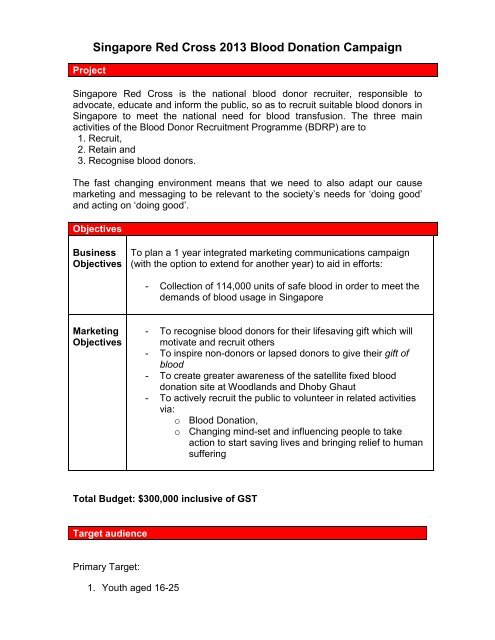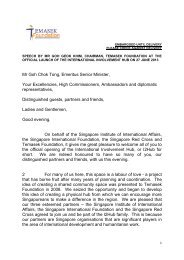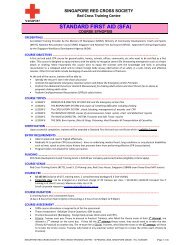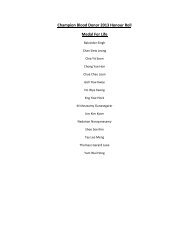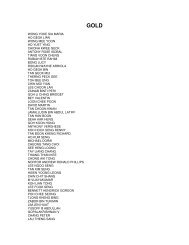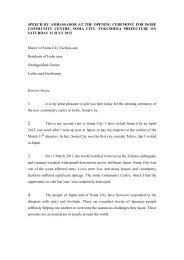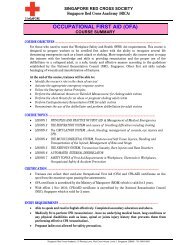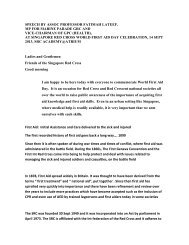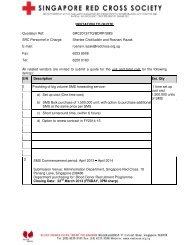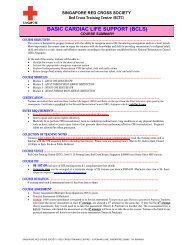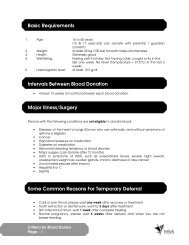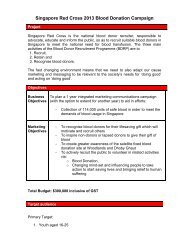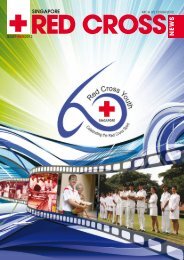Singapore Red Cross 2013 Blood Donation Campaign
Singapore Red Cross 2013 Blood Donation Campaign
Singapore Red Cross 2013 Blood Donation Campaign
- No tags were found...
You also want an ePaper? Increase the reach of your titles
YUMPU automatically turns print PDFs into web optimized ePapers that Google loves.
Project<br />
<strong>Singapore</strong> <strong>Red</strong> <strong>Cross</strong> <strong>2013</strong> <strong>Blood</strong> <strong>Donation</strong> <strong>Campaign</strong><br />
<strong>Singapore</strong> <strong>Red</strong> <strong>Cross</strong> is the national blood donor recruiter, responsible to<br />
advocate, educate and inform the public, so as to recruit suitable blood donors in<br />
<strong>Singapore</strong> to meet the national need for blood transfusion. The three main<br />
activities of the <strong>Blood</strong> Donor Recruitment Programme (BDRP) are to<br />
1. Recruit,<br />
2. Retain and<br />
3. Recognise blood donors.<br />
The fast changing environment means that we need to also adapt our cause<br />
marketing and messaging to be relevant to the society’s needs for ‘doing good’<br />
and acting on ‘doing good’.<br />
Objectives<br />
Business<br />
Objectives<br />
To plan a 1 year integrated marketing communications campaign<br />
(with the option to extend for another year) to aid in efforts:<br />
- Collection of 114,000 units of safe blood in order to meet the<br />
demands of blood usage in <strong>Singapore</strong><br />
Marketing<br />
Objectives<br />
- To recognise blood donors for their lifesaving gift which will<br />
motivate and recruit others<br />
- To inspire non-donors or lapsed donors to give their gift of<br />
blood<br />
- To create greater awareness of the satellite fixed blood<br />
donation site at Woodlands and Dhoby Ghaut<br />
- To actively recruit the public to volunteer in related activities<br />
via:<br />
o <strong>Blood</strong> <strong>Donation</strong>,<br />
o Changing mind-set and influencing people to take<br />
action to start saving lives and bringing relief to human<br />
suffering<br />
Total Budget: $300,000 inclusive of GST<br />
Target audience<br />
Primary Target:<br />
1. Youth aged 16-25
Secondary Target:<br />
a. Individuals studying in upper secondary schools or tertiary<br />
institutions.<br />
b. Student leaders to instil a culture of blood donation as their<br />
cornerstone for community give back<br />
1. PMEBs aged 26-40<br />
Challenges<br />
Key<br />
Challenges<br />
- Barriers towards blood donation; Fear of pain and needles<br />
(61%)’ Inconvenience (41%); and Lack of self motivation<br />
(18%) – based on SRC Synovate research (where 88% of<br />
respondents had tertiary education)<br />
- Public perception that there is “enough” blood stock<br />
- Limited campaign budget<br />
- Lower collection during the school holidays, long holiday<br />
weekends and festive periods, such as the month of Chinese<br />
New Year, Ramadan, National Day and year end Christmas<br />
and New Year’s celebration.<br />
Opportunities<br />
Key<br />
Opportunities<br />
- Expansion of key areas of partnerships with existing<br />
educational institutions, corporate and government bodies<br />
- Using best models in the partnerships to attract more<br />
partnerships<br />
- Greatest effective channels to increase awareness : School<br />
(53%); MRT ads (49%); social networks (48%); TV Ads<br />
(45%) and Road-shows (42%)– based on SRC Synovate<br />
research<br />
- Using social media and new traditional forms of marketing<br />
and branding venues for the campaign<br />
- <strong>Blood</strong> donors tended to recall basic messages of “blood<br />
donations saves lives” ; “reminder/for encourage blood<br />
donation”; and “anyone can donate blood despite our<br />
differences” – based on SRC Synovate research<br />
- Decentralization of satellite fixed blood donation sites with<br />
opening of <strong>Blood</strong>bank@ Woodlands and<br />
<strong>Blood</strong>bank@Dhoby Ghaut means that donors have more<br />
choices are where and when to donation
Desired Outcomes (in terms of relationship development, awareness,<br />
education, priorities, profile building)<br />
With a maximum budget of $300,000, to create a IMC campaign to<br />
Deliverables deliver the following outcomes:<br />
- ATL and BTL applications island-wide<br />
Including conceptualisation, production and media buys for<br />
advertisements<br />
- Digital Media Engagement<br />
- Public Relations<br />
- Community Engagement<br />
- Design of year end diary<br />
Note: $100,000 of total budget is earmarked specifically for<br />
targeted marketing/location based advertising (including production<br />
and media buys), to drive traffic to the three (3) bloodbanks.<br />
- Roll out period:<br />
o June – August <strong>2013</strong>: World <strong>Blood</strong> Donor Day Period<br />
in June, with sustenance activities leading to the long<br />
National Day/Hari Raya Puasa weekend.<br />
o Dec – April 2014: Year-end activation to boost blood<br />
donation, with sustaining activities leading to the<br />
potential opening of a new blood collection centre in<br />
April 2014<br />
o Boost collection during traditional ‘dips’ such as<br />
school holidays, festive periods, long weekends<br />
The campaign should result in:<br />
- Increase in youth first time donors<br />
- Increase in youth repeat donors<br />
- Increase in first time donors, and repeat donors<br />
- Increase in outreach (Media talks, FB likes etc)<br />
- Increase in sign-up of volunteers for other blood donationrelated<br />
activities<br />
Evaluation Criteria<br />
The<br />
National<br />
<strong>Blood</strong><br />
Programme<br />
will<br />
- Strategic ability to achieve campaign objectives, based on<br />
o Strength of Creative Idea & Potential Impact<br />
o Outreach to target audience, based on strength of<br />
media mix<br />
o Effectiveness of campaign sustenance
determine<br />
the winning<br />
pitch based<br />
on:<br />
o Value (Return on Investment)<br />
o Commitment and Caliber of the Team assigned to<br />
Account<br />
Key milestones*<br />
Key milestone: Period Due date/End date:<br />
Collection of Tender<br />
Jan <strong>2013</strong><br />
28 January – 1 February<br />
Documents<br />
Submission of Tender Feb <strong>2013</strong><br />
28 February<br />
Proposals<br />
First cut selection of agency March <strong>2013</strong> 8 March<br />
Big Ideas (Proposal by March <strong>2013</strong><br />
25 March<br />
Agency)<br />
Final Confirmation March 1 April<br />
1 st Roll-out plan and<br />
Grand Launch: 01 30 August <strong>2013</strong><br />
materials<br />
June <strong>2013</strong><br />
2 nd Roll-out plan and<br />
materials<br />
1 Dec <strong>2013</strong> 31 March 2014<br />
Enclosed – Will be sent to agencies registering interest by 11 February <strong>2013</strong><br />
1/ Evaluation of Effectiveness of Past <strong>Campaign</strong>s (Synovate research)<br />
2/ <strong>Blood</strong> <strong>Donation</strong> Booklet – all you need to know about blood donation<br />
3/ Useful Trends and Information<br />
4/ Infographic on <strong>Blood</strong> <strong>Donation</strong><br />
Annex A: Useful Information on <strong>Blood</strong> <strong>Donation</strong><br />
• Units of safe blood were collected in 2011 (103,000) and 2012 (107,000)<br />
• Target of 114,000 units is a 7% increase from the amount collected in<br />
2012.<br />
• There are about 70,000 donors, in which about 20,000 are new donors,<br />
and about 49,000 are repeat donors.<br />
• Usable blood is blood that has passed screening by <strong>Blood</strong> Services Group.<br />
Each unit of donated blood goes through rigorous testing to detect for<br />
diseases such as HIV, Hepatitis B and C, and other forms of STD. Less<br />
than 0.5% of the blood donated have such occurrences.<br />
• The usual drop-out rate or deferred donors is approximately 35% of those<br />
donors who have registered for blood donation. Most of the deferment is<br />
due to low haemoglobin level, or due to travel to Malaria affected areas, or<br />
due to temporal illnesses like the common cold, cough or fever.


